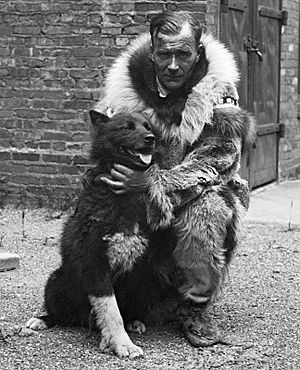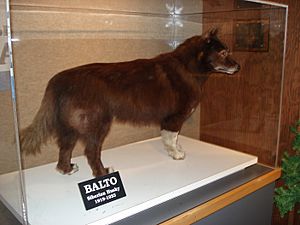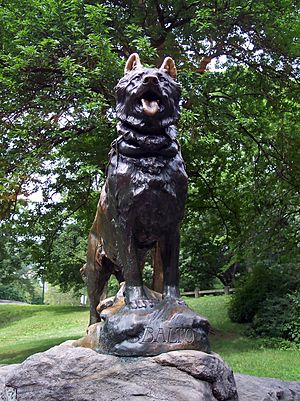Balto facts for kids

Balto with Gunnar Kaasen, his musher in the 1925 Serum Run.
|
|
| Species | Canis lupus familiaris |
|---|---|
| Breed | Siberian Husky |
| Sex | Male |
| Born | 1919 Nome, Territory of Alaska |
| Died | March 14, 1933 (aged 13–14) Cleveland, Ohio, United States |
| Resting place | Cleveland Museum of Natural History |
| Nation from | United States of America (Territory of Alaska) |
| Occupation | Sled dog |
| Known for | 1925 serum run to Nome |
| Owner | Leonhard Seppala |
| Appearance | Black with white "socks", "bib", and partial white markings on belly and tip of the muzzle, which advanced with age (including white markings around the eyes when he was old). Eyes were dark brown. |
| Named after | Samuel Balto |
Balto (born 1919, died March 14, 1933) was a brave Siberian Husky sled dog. He became famous for his part in a very important journey. This journey was called the 1925 serum run to Nome.
In 1925, Balto helped deliver life-saving medicine to the town of Nome, Alaska. The town was facing a serious illness outbreak. Balto led a team of sled dogs driven by Gunnar Kaasen on the last part of this urgent trip. After his heroic deed, Balto lived a comfortable life at the Cleveland Zoo. When he passed away at 14 years old, his body was preserved. You can still see him today at the Cleveland Museum of Natural History.
Contents
The Great Race for Medicine
What was the 1925 Serum Run?
In January 1925, doctors in Nome, Alaska discovered a dangerous illness. It was called diphtheria. This sickness could spread quickly among the town's young people. The only medicine, called antitoxin, was far away in Anchorage, Alaska.
The weather was too cold for airplanes to fly. So, officials decided to use dog sled teams. The medicine traveled by train from Anchorage to Nenana. From there, many dog sled teams took turns carrying it. This was like a relay race.
Facing the Alaskan Blizzard
More than 20 dog drivers, called mushers, joined the relay. They faced terrible weather. There was a huge blizzard with temperatures as low as -23 degrees Fahrenheit (-30 degrees Celsius). Strong winds made it even worse. People all over the world followed the news of this amazing race.
On February 2, 1925, the musher Gunnar Kaasen took over the medicine package. He was driving a team of dogs that belonged to Leonhard Seppala. Balto was one of the dogs in this team. They were at a place called Bluff.
Balto's Final Leg of the Journey
Kaasen and his team reached Port Safety. This was the last stop before Nome. The next musher, Ed Rohn, was supposed to take over. But Rohn thought the bad weather had stopped Kaasen. So, he was asleep.
Kaasen decided not to wake Rohn. He wanted to save time. He continued the last 25 miles (40 km) to Nome himself. Balto led the way. They arrived in Nome at 5:30 in the morning. All the medicine was safe. It was ready to be used by midday.
Balto's Fame and Other Heroes
Was Balto the Only Hero?
After the serum run, Balto and Gunnar Kaasen became very famous. However, some people wondered if Balto truly led the team. Leonhard Seppala, Balto's owner, said Balto "was never in a winning team." He even called him a "scrub dog."
Pictures and videos of Balto and Kaasen were taken hours after they arrived. This made some people think Balto's role might have been made bigger for the news. Historians believe Balto might have run alongside another dog, Fox, as a co-leader. He probably didn't lead the team all by himself.
Many mushers also felt that Kaasen wanted all the glory for himself. They thought this was why he didn't wake Ed Rohn at Port Safety.
The Real Long-Distance Runner: Togo
While Balto became very famous, another dog named Togo actually traveled the longest and most dangerous part of the serum run. Leonhard Seppala, Togo's musher, was not happy about Balto getting all the credit.
Seppala said that all the dogs and drivers did their best. But he felt that Togo deserved more special mention. He said he never thought Balto's team was good enough for even a short relay. Many mushers today still feel that Togo's amazing effort is often forgotten. The important contributions of Alaska Natives and their teams are also often overlooked. They covered almost two-thirds of the entire run.
Balto's Statue and New Home
A statue of Balto was put up in New York City's Central Park. This happened on December 17, 1925, just ten months after the serum run. Balto himself was there when the statue was shown to the public!
The statue has a plaque that says:
Dedicated to the indomitable spirit of the sled dogs that relayed antitoxin six hundred miles over rough ice, across treacherous waters, through Arctic blizzards from Nenana to the relief of stricken Nome in the Winter of 1925.
Endurance · Fidelity · Intelligence
After his fame, Balto and his team traveled around. They were part of a show called vaudeville. Balto could not have puppies because he was neutered when he was young. Later, the dogs were sold and ended up in a museum in Los Angeles. They were kept in a small, unhealthy area.
A businessman from Cleveland named George Kimble found them. He was upset by how they were treated. Kimble worked with a newspaper to bring Balto and his friends to Cleveland, Ohio. On March 19, 1927, Balto and six other dogs arrived in Cleveland. They received a hero's welcome with a big parade. The dogs then went to live at the Brookside Zoo, which is now the Cleveland Metroparks Zoo.

When Balto died in 1933, his body was preserved by a taxidermist. It was then given to the Cleveland Museum of Natural History. In 1998, people in Alaska wanted Balto to return home. The Cleveland Museum decided to keep him. However, Balto did visit the Anchorage Museum of History and Art for five months in 1998. He drew huge crowds there. Balto also visited the Anchorage Museum again in 2017 for another exhibit.
See also
 In Spanish: Balto para niños
In Spanish: Balto para niños
- Iditarod Trail
- Hachikō
- Togo (dog)
- List of individual dogs


